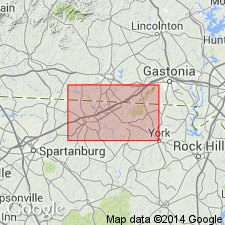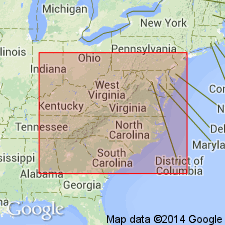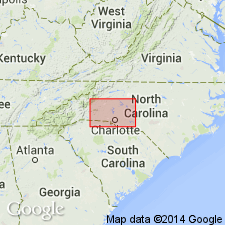
- Usage in publication:
-
- Yorkville granite*
- Modifications:
-
- Original reference
- Dominant lithology:
-
- Granite
- AAPG geologic province:
-
- Piedmont-Blue Ridge province
Summary:
Yorkville granite. Dark-gray coarse-grained granite. Intrusive into Roan gneiss. Believed to be younger than Whiteside granite. Age is Late Carboniferous(?).
[Named from exposures at Yorkville (also called York), York Co., northwestern SC. Extends to southern NC.]
Source: US geologic names lexicon (USGS Bull. 896, p. 2391).

- Usage in publication:
-
- Yorkville granite
- Modifications:
-
- Areal extent
- AAPG geologic province:
-
- Piedmont-Blue Ridge province
Summary:
Pg. 759-760. Yorkville granite. Exposed over large area south and southeast of Henry Knob, which is 3 miles west of Clover, South Carolina. [Age is Permian.]
Source: US geologic names lexicon (USGS Bull. 1200, p. 4331).

- Usage in publication:
-
- Yorkville quartz monzonite*
- Modifications:
-
- Revised
- Age modified
- AAPG geologic province:
-
- Piedmont-Blue Ridge province
Summary:
Yorkville granite revised to Yorkville quartz monzonite. Age is Early Mississippian(?) in this report. [Yorkville granodiorite originally proposed in this report, but rejected until composition was determined. Authors finally agreed to usage of quartz monzonite in March 1957. Age modification based on zircon age determinations.]
Source: GNU records (USGS DDS-6; Reston GNULEX).

- Usage in publication:
-
- Yorkville Quartz Monzonite*
- Modifications:
-
- Age modified
- Geochronologic dating
- AAPG geologic province:
-
- Piedmont-Blue Ridge province
Summary:
Pg. 89 (geol. time scale), 93 (table 7), 94 (table 8), 108-109. Yorkville Quartz Monzonite. Age changed from Early Mississipian(?) --to-- Permian on basis of Lead-alpha age determination. (Authors follow revised time scale of Holmes, 1959, Edinburgh Geol. Soc. Trans., v. 17, pt. 3, p. 183-216.)
Source: Publication; Changes in stratigraphic nomenclature, 1964 (USGS Bull. 1224-A, p. A21).

- Usage in publication:
-
- Yorkville
- Modifications:
-
- Not used
- AAPG geologic province:
-
- Piedmont-Blue Ridge province
Summary:
Coarse-grained, porphyritic, gneissic biotite granite in Kings Mountain belt mapped as Yorkville by Espenshade and Potter is renamed High Shoals Granite to distinguish it from non-foliated granites like the type Yorkville near York, SC.
Source: GNU records (USGS DDS-6; Reston GNULEX).

- Usage in publication:
-
- Yorkville Quartz Monzonite†
- Modifications:
-
- Abandoned
- AAPG geologic province:
-
- Piedmont-Blue Ridge province
Summary:
Yorkville Quartz Monzonite abandoned because granites mapped previously as Yorkville, including the type Yorkville near York, SC, are redefined here as Churchland Plutonic Suite, or as High Shoals Granite by Horton (1984).
Source: GNU records (USGS DDS-6; Reston GNULEX).
For more information, please contact Nancy Stamm, Geologic Names Committee Secretary.
Asterisk (*) indicates published by U.S. Geological Survey authors.
"No current usage" (†) implies that a name has been abandoned or has fallen into disuse. Former usage and, if known, replacement name given in parentheses ( ).
Slash (/) indicates name conflicts with nomenclatural guidelines (CSN, 1933; ACSN, 1961, 1970; NACSN, 1983, 2005, 2021). May be explained within brackets ([ ]).

